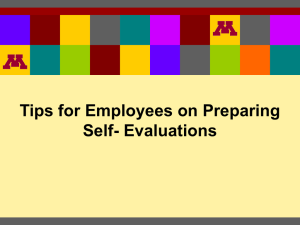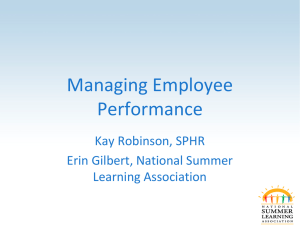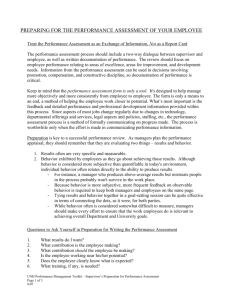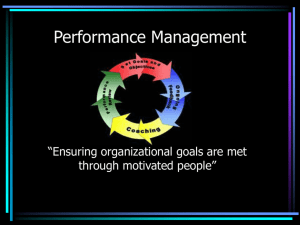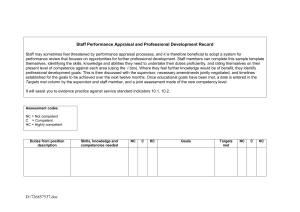Supervisor’s Guide to Performance Appraisals
advertisement
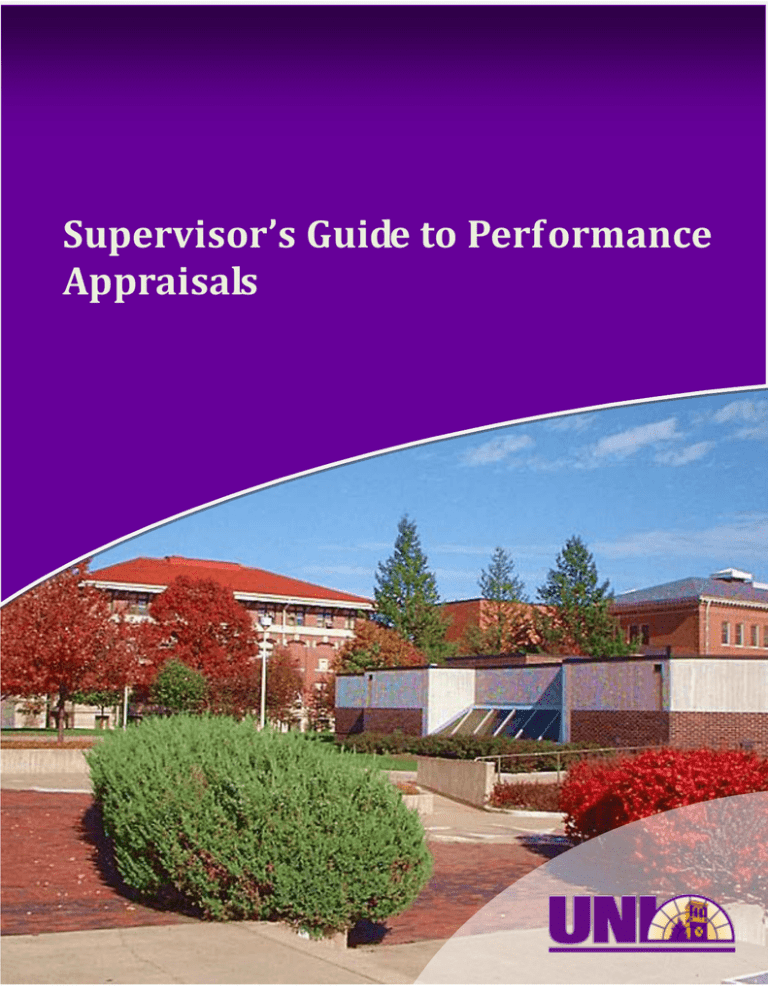
Supervisor’s Guide to Performance Appraisals Table of Contents Introduction ...............................................................................................................................3 Benefits of Productive Performance Meetings .......................................................................3 Performance Goals Help Employees .......................................................................................3 Performance Goals Help Supervisors ......................................................................................4 Preparing the Employee and Scheduling the Performance Meeting .....................................4 Completing the Annual Performance Summary Form ...........................................................4 Conducting the Performance Meeting .....................................................................................7 Helping Employees Set Career Goals......................................................................................9 Guidelines for Handling a Meeting with a Poor Performer...................................................10 Discussing Employee Attitude Problems..............................................................................11 Addressing Emotional Situations ..........................................................................................11 Crying ....................................................................................................................................11 Shouting ................................................................................................................................12 Walking Away ........................................................................................................................12 Becoming Silent.....................................................................................................................12 Quick to Agree .......................................................................................................................12 Preparing for Next Year’s Performance Appraisal................................................................12 Documenting Job Performance .............................................................................................13 Coaching Employee Performance .........................................................................................14 Planning and Preparation ......................................................................................................14 Conducting a Coaching Session ............................................................................................15 Action-planning and Follow-up...............................................................................................16 How Human Resource Services Can Assist .........................................................................17 Page | 2 Supervisor’s Guide to Performance Appraisals Introduction The following guidelines are designed to assist you in conducting performance appraisals of employees who report to you. It is very important to assess job-related performance and not personality unless it relates directly to the employee’s performance. Please keep in mind that you are a role model for those who report to you. There is no substitute for courtesy, sensitivity, and a common sense approach to the performance appraisal process. This guide has been developed in conjunction with the revision of the annual appraisals forms used for Merit (AFSCME) employee by the 2000 Merit Evaluation Task Force, including task force members and employees from AFSCME, the Department of Residence, Library, Physical Plant, Print Services, and Human Resource Services. In certain instances, reference is made to the actual evaluation forms used for Merit employees, including the Annual Performance Summary and the Discussion Guide for Annual Performance Summary. This guide may also be used as a reference tool by supervisors who conduct performance appraisals of other employee classifications, such as Professional & Scientific. Where reference is made to the specific Merit evaluation forms, please substitute the forms that you have been provided for use. Benefits of Productive Performance Meetings A productive performance meeting serves as a collaborative planning session during which both the supervisor and the employee can take an in-depth look at past and current performances and can together set new goals and objectives for the coming year. The performance meeting helps the supervisor and employee establish a clearer understanding of the employee’s job duties, responsibilities, and priorities. It also provides an opportunity for the supervisor to coach the employee on how to become more proficient and productive. Establishing performance goals provides direction and helps the employee and supervisor in the following ways: Performance Goals Help Employees: • Find out how they are doing. • Know what is expected of them. • Take responsibility for their performance. • Learn their performance strengths and weaknesses. • See where their goals support organizational goals. • Direct efforts where they can do the most for their own careers and for group and organizational success. Page | 3 • Feel that they are taken seriously as individuals and that the supervisor is truly concerned about their needs and goals. Performance Goals Help Supervisors: • Develop an objective means for evaluation employees. • Tie individual tasks, goals, and direction to group and organizational goals. • Work with employees on career development plans and paths. • Identify where individuals need coaching and training. • Provide recognition and motivation to employees. • Document an employee’s progress towards reaching goals. For further information regarding the performance review process, you may borrow training videos from Human Resource Services by contacting the receptionist at 319-273-2422. Preparing the Employee and Scheduling the Performance Meeting Advise the employee of the performance meeting at least one week in advance. Ask the employee to complete the optional Discussion Guide for Annual Performance Summary to bring to the meeting. The purpose of the Discussion Guide for Annual Performance Summary is to encourage communication and to provide discussion points between the employee and supervisor during the performance meeting. The Discussion Guide for Annual Performance Summary can also be obtained from UNI’s Forms Repository located at http://access.uni.edu/forms/index.shtml. Also, let the employee know that you intend to discuss his/her personal career objectives at the meeting. If you have done this in the past, you may want to provide the employee with a written list of goals that you both set during the last performance meeting. Ask the employee to think about what progress has been made toward those goals and what goals he/she would adjust the priorities that have been set. The date and time that you schedule the meeting for should be mutually convenient to you and the employee. Set aside at least one hour with no ringing telephones or interruptions and find a private room for the meeting. When scheduling consecutive performance meetings, ensure there is enough time between them so you do not rush the appraisal process. Completing the Annual Performance Summary Form The better prepared you are for the performance appraisal meeting, the more productive your discussion will be. It all starts with your completion of the Annual Performance Summary formthe more time and effort you put into completing it, the better prepared you will be for the Page | 4 Supervisor’s Guide to Performance Appraisals appraisal meeting. Before sitting down to complete the Annual Performance Summary for an employee, gather the following information and documents for your review and reference: • • • Employee’s job description; Date employee began present position; Length of time the employee has reported to you; • • • Record of employee’s attendance during past year; Your notes or journal regarding the employee’s performance during the past year; Current projects the employee is working on and employee’s progress; • Examples of work problems you want to discuss; • • • Examples of employee’s work over the past year and recent work; How employee relates to co-workers, internal and external customers, and others; Level of employee’s technical skills; • • Employee’s educational background and experience; List of job and career objectives drawn up during past performance review; • • List of training and development courses attended by employee during past year; List of available training courses appropriate for employee for upcoming year. When completing the evaluation form, consider whether the employee met his/her goals for the period. If not, were there any outside circumstances (new orders, staff cuts, equipment problems) that limited the employee’s ability to meet goals? Did you provide the employee with feedback on progress toward goals during the year? Do you have records of specific examples of successes, improvements, or weaknesses? Do your examples include feedback form internal and external customers, other supervisors, etc? When rating an employee on different factors, base the ratings on how well the employee performed his/her job. Be careful of dramatic declines such as “exceeds expectations” to “needs improvement.” The supervisor must address all “needs improvement” ratings as well as other issue, in the “supportive details or comments” section of the form. All comments made should be meaningful and consistent with performance rankings. It is important to be aware of, and to guard against, the following common tendencies: Page | 5 Rating Tendency Halo Effect Opposite of Halo Effect Central Tendency Recent Behavior Spillover Effect Status Effect Same as Me Personal Bias/Prejudice Explanation A tendency to rate high on one quality which may influence a higher than deserved rating on another quality, such as rating someone high because you personally like him/her. A rating of unsatisfactory on one quality may influence a lower than deserved rating elsewhere, such as rating someone low because you do not like his/her personal style. Rating performance as average or around the midpoint. This is the most common and serious of the rater tendencies. Basing the rating on recent performance on a project rather than overall performance throughout the past year. Allowing past performance appraisals to unjustly influence current ratings. Over-rating employees in jobs held in high esteem and under-rating employees in lower level jobs or those held in low esteem. Rating an employee higher than deserved because of dissimilar personality characteristics from the rater. Rating affected by national origin, age, sex, race, religion, physical characteristics, manner of speech, etc. Keep your appraisal or comments regarding the employee’s performance specific, related to the employee’s goals, fair and objective, and based on what occurred during the entire review period. The appraisal should be concerned solely with job behaviors and efforts, not personality. Avoid comparing the employee’s performance to that of other employees. Considering the following criteria when preparing employee performance documentation and evaluations: Criteria Accuracy Behavior Completeness Consistency Effort Individualized Measurable Results Timeliness Explanation Who did what, when, and what was the result? What did the employee actually do? Are all the relevant points covered/ Does documentation cover the same performance areas with the same level of detail for all employees in the same job/ Does employee get credit for taking responsibility, putting in extra time, volunteering, following instructions, etc? Does it relate to the particular employee’s goals? Can progress in meeting performance goals be measured or given numerical support? Can you show that the employee did or did not complete the task successfully? Does the documentation reflect incidents in the current review period? Once the evaluation form is completed, it is recommended that you review it with your supervisor before meeting with the employee to ensure the both levels of management are in agreement regarding the employee’s performance. Page | 6 Supervisor’s Guide to Performance Appraisals Conducting the Performance Meeting 1. Put the employee at ease by creating a sincere and open atmosphere for joint discussion. 2. Establish the purpose of the discussion. Advise the employee what you would like to accomplish during the meeting. 3. Review the employee’s overall job requirements and responsibilities. Going over the job description with the employee allows you to discuss the work that the employee does on a daily basis. If the two of you disagree on the relative importance of specific job aspects, it will come out now, and it will also give you the opportunity to discuss any problems the employee is having performing the various job responsibilities. 4. Review the performance objectives and goals established during the last performance meeting with the employee. a. Discuss objectives/goals that have been reached. How has that improved the employee’s skills and performance? b. Discuss objectives/goals that need further work. What obstacles have prevented the employee form reaching any objectives? Decide if time frames set for reaching the objectives need to be adjusted. 5. Provide recognition for desirable behavior, especially since the last review. Let employee know how much you value and appreciate their work. 6. Ask for the employee’s views on problems, suggestions for changes, improvements, etc. a. Do not interrupt the employee’s commentary. If the employee is upset, let him/her blow off steam. Be a good listener. b. Thank the employee for his/her input. If the meeting has included discussion of major concerns about the quality of the employee’s performance, express confidence that the two of you can successfully work through the difficulties together. 7. Outline one or two areas of performance where improvements are needed and ask for the employee’s suggestions. a. Do not unload-keep the meeting as upbeat and positive as possible, but be honest and accurate. b. Avoid using subjective, vague, or overly broad descriptions, such as “poor attitude” or “no initiative.” Give specific, objective comments and/or examples. Page | 7 Examples of Subjective Comments Lacks customer orientation. Chronically absent. Does not care about the quality. Lacks interest in the work. Examples of Objective Comments Does not greet customers quickly. Absent six days last month. Has an error rate of 10%. Missed the due date for assignment. c. Be consistent. If an issue (weakness of performance) was mentioned on the previous performance appraisal, it should be mentioned again if it is still an issue. An omission may lead to the assumption that the problem has been resolved. Conversely, if there has been improvement since the last appraisal, acknowledge it. 8. Problems that are not related to work performance, such as absenteeism or tardiness, generally should be handled as they occur, not as part of the annual performance appraisal. If it appears that the problem may be related to personal or family medical issues, refer the employee to Human Resource Services in order to determine if the employee qualifies for leave under the Family Medical Leave Act. 9. Outline and discuss action plans for improvement with the employee. Let the employee know what behavior you expect, whether you desire to reinforce positive behavior or make a change. Encourage the employee to make as many suggestions for selfimprovement as possible. Include training or development plans when appropriate. Set a realistic timeline for improvement; if you need assistance, consult with Human Resource Services. 10. Discuss whether the employee’s ultimate career objective as identified at his/her last performance review remains the same or has changed. If it has changed, how will this affect the objectives that have already been set? 11. Ask the employee if there is any remaining items on the Discussion Guide for Performance Appraisal that they would like to address. 12. Set new career objectives for the upcoming year. Discuss what the employee needs to learn to reach these objectives and how the employee can obtain the knowledge and experience needed. a. Assign responsibility for reaching these goals. Let the employee know to what extent you will help him/her and what the employee must do independently. b. Decide together on a first step that will start the employee toward reaching a tangible goal. Page | 8 Supervisor’s Guide to Performance Appraisals 13. Be prepared to discuss the employee’s concerns regarding wage increases, promotional opportunities, etc. Be as honest as possible and do not set unreachable expectations. 14. Summarize the appraisal meeting interview and review objectives/goals set for performance improvement. Attempt to obtain an acknowledgment from the employee that indicates there is a clear and mutual understanding and agreement. Bring the interview to a close by: a. Commenting on the positive aspects of the employee’s performance, b. Providing a word of encouragement, c. Offering assistance, d. An invitation for formal discussions anytime the employee wishes. Helping Employees Set Career Goals The reason for setting new objectives/goals is so employees can continue to feel a sense of achievement and satisfaction in the work they do. Goals can be broad based and tied to the university’s strategic plan, or they can be related to specific departmental goals or job expectations. If the employee chooses inappropriate goals, or if they have difficulty focusing on assigned goals, you can help them get on track by asking the right questions. The following are some sample questions that you might find useful: 1. What would you like your next position to be? How do you think you can best work toward reaching that goal? 2. What do you feel would be helpful for your job or career development? Is there any kind or type of training you would like to receive? 3. What long-range goals would you set for yourself? How are you working toward reaching those goals now? What do you plan for the future? 4. How is your present job preparing you for the goals you have set for yourself? Do you need to find out more? 5. What do you know about the requirements for the goals you have set for yourself? Do you need to find out more? 6. What changes will you have to make to reach the goals you are setting? Can they be made within the boundaries of your present position? Page | 9 Guidelines for Handling a Meeting with a Poor Performer 1. Be honest and frank regarding performance deficiencies. Address areas that the employee has control over and can change. 2. Use tact and sensitivity without getting personal when discussing the employee’s work performance. 3. Have documentation available. Mark entries in your employee notes or journal with paperclips so that you can quickly show examples of problems the employee has had with performance and/or behavior during the past year. 4. Make sure you have also documented the times you have spoken to the employee about his/her performance. This chronological history will assist you when you discuss specific dates of performance deficiencies. 5. Have written performance standards to show the employee (these standards should be distributed to all employees when they are hired or when a promotion is granted). 6. Show the employee examples of how his/her work do not meet performance objectives. Consider and discuss the possible cause of the performance deficiencies. 7. Set improvement goals. Set short-term goals that are specific and achievable for the employee. Explicitly state the level of performance you expect for the person’s work to be considered acceptable. Make a “contract” with the employee to improve performance within a certain amount of time. Set measurable standards for improvement and work together to determine how the performance objectives can be accomplished. Be positive about the employee’s ability to improve. 8. Establish an action plan. If appropriate, arrange for extra training by yourself or a senior co-worker, or closer supervision by yourself. Action plans may also include job reassignment or transfer, referral to the employee assistance program for counseling, lower performance standards for a short time, etc. 9. Schedule a “follow-up on progress” meeting in one or two months to assess the progress that has been made, or establish another way to monitor the worker’s progress towards achieving the established goals. 10. Be honest with the employee about his/her future without being patronizing or admonishing. Spell out exactly what the employee has to do to improve and what the consequences will be if he/she does not change the performance. You may wish to consult with Human Resource Services for guidance on addressing employee performance issues and to ensure consistency across campus in handling similar situations. 11. If performance does not improve after a reasonable period of time and you believe you need to start the progressive disciplinary process, contact Human Resource Services. Page | 10 Supervisor’s Guide to Performance Appraisals Discussing Employee Attitude Problems Attitude problems can damage overall performance. For example, if an employee has a surly attitude that is displayed when he/she interacts with co-workers, it can adversely affect workflow in the department. In contrast, arriving late to work, being inconsiderate of others, or being careless with university property may not directly affect the employee’s work, but may be disruptive to the rest of the department and can definitely damage the morale of the employee’s co-workers. Discussing an attitude problem with an employee can be a more uncomfortable experience for a supervisor than citing inadequate performance. The following guidelines can help you plan what to say: Don’t Say I don’t like your attitude. Your personality is too abrasive toward your co-workers and to me. It’s too bad you’ll never succeed because of your attitude. Do Say Your behavior indicates that you resist doing work that is asked of you. (Cite specific examples of inappropriate behavior.) Please speak more respectfully to our coworkers and your supervisors. You have the ability to perform well on the job and to be successful. In order for this to occur, you need to change the behaviors that are standing in the way of your success on the job. It is best to avoid the word “attitude” altogether, as it has a patronizing tone. You can discuss specific negative behaviors you have documented and provide the employee with examples of positive behavior on the job. Addressing Emotional Situations Occasionally, an employee will react very strongly if disappointed in the review that is given. This can unnerve even the most experienced supervisor. Crying, shouting, walking away, or becoming silent are all reactions that can be very difficult to address. Here are some suggestions for getting through such a situation: • Crying: An employee in tears may not be able to discuss issues calmly. Try to minimize the employee’s embarrassment by empathizing and speaking in low, even tones. Offer compassion and some tissues. Ask the employee if he/she would like to talk a little later, or give the employee time to recompose himself/herself by leaving the room for a short time. Page | 11 • Shouting: Do not answer shouting with more shouting. Instead talk calmly, slowly, and firmly to the employee and do not appear frightened or agitated. If the shouting continues on without abatement, ask the employee to leave and say that you will schedule a time to continue the discussion when he/she has had time to calm down. If you feel threatened physically, contact Public Safety at 273-2712 for assistance. • Walking Away: Although it is impossible to have a discussion if the employee walks away, it may not be an entirely bad thing. Some people know they cannot face an issue and they leave rather than completely lose their temper. Don’t try to physically restrain someone who walks out on you. You can ask the person to please stay so that you can finish the discussion but if he/she doesn’t care to listen, do not force the issue. Let the employee leave and take up the discussion again when he/she has calmed down. If the employee continues to walk away whenever you attempt to address an issue, consult Human Resource Services for guidance on handling the situation. • Becoming Silent: An employee who is feeling hostility or resentment toward you may react by silence. Talk to the employee about whatever you need to, but do not push the issue by attempting to make small talk. Ask open-ended questions, such as “What would your approach to the problem be? Why do you think you were so successful in completing that project?” If the employee continues to refuse to talk, you may have to address the employee directly and request that he/she talk to you so that you can put the problem behind you. You may also want to reschedule the meeting for a time when the meeting will be more productive. If “becoming silent” continues to be a problem, consult Human Resource Services for guidance on handling the situation. • Quick to Agree: The employee may want to get out of the appraisal meeting as soon as possible. If this situation occurs, ask the employee to summarize main points. Use questions such as, “What is your understanding of the problem?” Make sure there is a mutual understanding of overall performance, goals and objectives before the meeting ends. Preparing for Next Year’s Performance Appraisal If your performance appraisal process did not go as smoothly as you would have liked this year, consider what steps you can take to improve the process for next year. Here are some possible suggestions: • Create a system for documenting each of your employee’s job performance. Document both good and poor performance, as well as any discussions you have with the Page | 12 Supervisor’s Guide to Performance Appraisals employee regarding performance issues. See Documenting Job Performance on page #13 of these guidelines for further information. • Communicate with and “coach” employees throughout the year regarding their job performance and your expectations. • Improve your listening and coaching skills so that you can better collaborate with your employees on making plans for performance improvement and goal setting. • Become familiar with training programs that can help your employees grow in their positions. • Follow up the plans you make with the employee with daily supervision and feedback. Make the appraisal process a continuous one. Monitor the progress an employee is making toward reaching goals and hold follow-up sessions to rethink strategies if goals need to be changed or employee progress is not satisfactory. • Become a “coach” instead of a boss to your employees. “Coaching” is an ongoing process designed to help the employee gain greater competence and overcome barriers to improving performance. See page #14 of these guidelines for an overview of the “coaching” process. Documenting Job Performance Documenting workplace behavior, both positive and negative, for all employees will assist you in the performance appraisal process more than anything else you can do. In addition, documentation provides the examples you need to discuss performance issues or concerns with an employee. In the event an employee’s performance does not improve, documentation is critical to the progressive disciplinary process. 1. A Critical Incident File should be established by the supervisor for every employee supervised. a. This file should contain both positive and negative information about the employee’s performance. b. Documenting observed performance (who, what, where, how) takes the subjective judgment factor out and enables you to base your evaluations on specific, objective, job-related behaviors. c. Allows you to be specific when meeting with an employee to discuss job performance. d. Examples can help the employee focus on past behavior and clarify future expectations. 2. Documentation provides accurate reflections of what a person did or did not do on the job over a period of time. It eliminates the need to remember details for a year or more. Page | 13 3. Documentation allows you to focus on the issues at hand, including the employee’s behaviors and not focus on the employee personally. 4. Documentation of continued poor performance provides support for the progressive disciplinary process. 5. Notes from the Critical Incident File are kept by the supervisor and are not part of the employee’s personnel file in Human Resource Services. They can, however, be used as documents during the investigation of any subsequent complaints made by the employee. Coaching Employee Performance Through coaching, you can actively involve employees in the problem-solving process and encourage them to take responsibility for their own professional development and success on the job. This will not only improve productivity, but will also build job satisfaction and motivation as employees begin to participate in decisions that affect their job performance. The coaching session process can be broken into three main segments: Planning and Preparation, Conducting the Coaching Session, and Action-planning and Follow-up. Within each segment are a number of individual steps, as defined below. Planning and Preparation: Step 1: Clarify your expectations. a. State your expectations in terms of behavior-specific, observable actions that can be measured. b. Describe specifically what kind of behavior you want or don’t want someone in the employee’s position to demonstrate. c. Make a list of the performance behaviors you hope the employee will change before you begin your session so that you will be ready to discuss. Step 2: Observe the employee’s performance. a. Focus on specific behaviors that can be measured and changed. b. Don’t just make note of what the employee is doing wrong. Keep track of what the employee is doing right so that you can build on his/her strengths during the coaching session. c. Determine the priority of the behaviors that the employee needs to improve. Don’t try to work on everything at once; select the behaviors that are most important for the employee’s success and concentrate on them first. You can work on other behaviors in future coaching sessions. Step 3: Analyze the problem. a. What aspects of the employee’s performance are unsatisfactory? Page | 14 Supervisor’s Guide to Performance Appraisals b. Is it worth my time to coach in this situation? c. Does the employee know my expectations? d. What obstacles are there to meeting those expectations? Are extenuating circumstances preventing the employee from doing his/her best? e. What negative or positive consequences follow performance? f. Could the employee change if he/she wanted to? Conducting the Coaching Session: Step 1: Create a comfortable coaching environment. a. Choose an appropriate time and place for coaching. If possible, select a location in which you can sit next to the employee, rather than across the desk. b. Establish rapport with the employee and clearly state the purpose for the meeting. Step 2: Describe the performance problem and your expectations for performance. a. Begin by describing the performance problem you identified in your observation of the employee, and compare the employee’s current performance to your expectations. b. Establish rapport with the employee and clearly state the purpose for the meeting. Step 3: Encourage employee self-assessment. a. Give the employee a chance to evaluate his/her own performance. Employees will be much more willing to participate actively in the coaching session if they have a chance to describe their own side of the situation. Hearing the employee’s perspective will also help you determine what extenuating circumstances could be affecting his/her performance. b. If employees are hesitant to offer their own ideas about their performance ask openended questions that start with the words who, what, where, when, and how. c. To be fully effective, a coach’s open-ended questions must be paired with active listening techniques. Listening involves keeping an open mind and interpreting, evaluating, and reacting to what the employee says. Step 4: Agree on the nature of the problem and the employee’s role in it. a. In order for coaching to be successful, and to determine whether it is needed at all, you and the employee must agree on the nature of the performance problem and the employee’s role in it. b. If you don’t agree with the employee’s view of the situation, you will need to provide more detailed feedback on performance to help the employee acknowledge the problem and take responsibility. c. If you are persuaded that the problem lies outside the employee, then this might be a good time to arrange for further training or some other option. Page | 15 Step 5: Explore alternative solutions. a. After you and the employee have agreed on the nature of the problem, the two of you can collaboratively explore solutions to it. b. The employee’s involvement in the problem-solving process will lead to a better solution, which in turn will lead to better performance and improved productivity for your entire team. c. Encourage the initiative, independence, and self-expression necessary for successful collaboration, through direct influence. Indirect influence consists of four basic techniques: accepting feelings, developing ideas, giving praise and encouragement, and asking open-ended questions. d. Provide detailed feedback to the employee regarding your performance observations. Step 6: Agree on a solution to the problem. a. As the employee and you collaborate on a specific solution, keep in mind that our solution must be realistic and workable in order to succeed. Stat your solution in terms of behaviors that the employee can perform and that you can observe and measure rather than in terms of attitudes or emotions. b. You can help your employee choose the best solution by asking open-ended “what if…?” questions to help the employee identify possible barriers to enacting the solution. Action-planning and Follow-up: Step 1: Create an action plan. a. Once you and the employee have agreed on a workable solution, ask the employee to outline a plan for putting the solution into action. Then ask the employee to state it verbally. b. Developing an action plan will not only give the employee direction for making the solution a reality, but it will also help build employee commitment to seeing the solution work. Step 2: Monitor employee progress. a. After you and the employee have agreed on an action plan, schedule time when you can meet and discuss the employee’s progress. Schedule your follow-up meeting far enough in the future that the employee will have time to put the solution into practice but not so far off that he/she will begin to think that you’ve forgotten about the matter. b. During the time period between, make note of what you observe, both the behaviors you want to reinforce and the behaviors that need further improvement. Record specific examples of each that you can share with the employee during the follow-up session. Page | 16 Supervisor’s Guide to Performance Appraisals Step 3: Provide follow-up coaching. a. Like your original coaching session, you follow-up coaching session will give you a chance to provide the employee with feedback on what you have observed about the employee’s performance and give the employee a chance to describe any barriers he/she may have encountered. b. You can also provide the employee with informal follow-up coaching as you observe his/her performance. Informal follow-up coaching as you observe his/her performance and give the employee a chance to describe any barriers he/she may have encountered. How Human Resource Services Can Assist Human Resource Services can assist supervisors in a number of ways with regard to the performance appraisal process and addressing employee performance problems, including: 1. Reviewing a performance appraisal for completeness and proper wording prior to the appraisal meeting. 2. Helping make a decision regarding overall evaluation. 3. Answering questions regarding the availability of training and development programs. 4. Assisting in the counseling effort as it relates to an employee’s poor performance. 5. Providing guidance with regard to the progress of the disciplinary process. Page | 17
